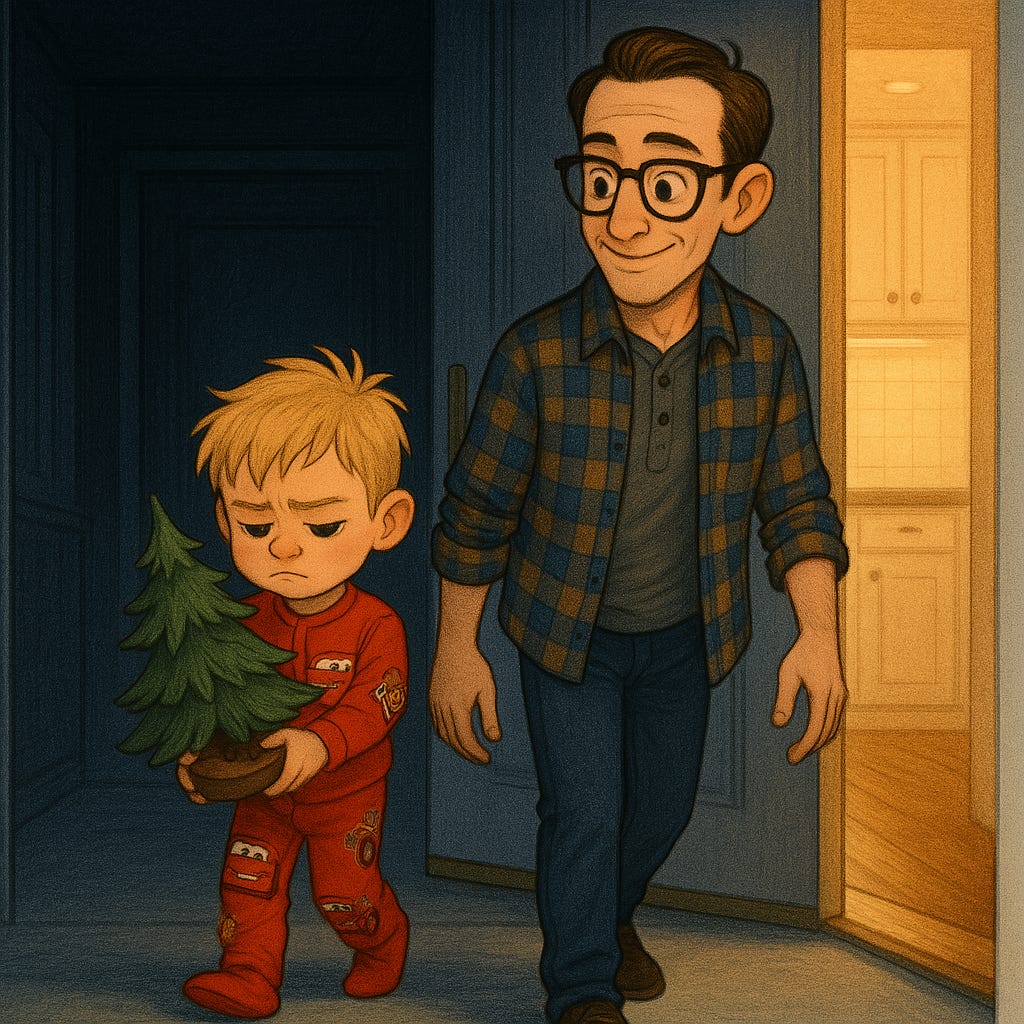What We Choose to Carry
Because sometimes, what we need isn’t there—and we have to carry something anyway.
I followed my son out of the garage, watching him sulk. As a writer, I couldn't help but note the juxtaposition of his body language against his bright red Lightning McQueen pajamas and the small, beat-up desktop Christmas tree he carried—on March 29. It was 9 p.m., more than an hour past his bedtime.
We'd come to the garage on a fruitless quest to find a Hot Wheels ambulance—no—the Hot Wheels ambulance. Not that one. The other one. The one that wasn't on the floorboard of my wife's car with eight other Hot Wheels, but instead lost somewhere at a friend's house almost an hour's drive away.
This was just one leg in the nightly parental quest: peace found only when the children are finally asleep. Bedtime is never easy, but it typically follows a basic framework: My wife takes our daughter, and I take our son. The baby collapses in under an hour, my wife comes in, and we double-team the boy.
Tonight, though, we've traded kids twice. As I followed my son from the garage to our kitchen, my wife held a metaphorical stopwatch as our 18-month-old ran gleeful laps from the glider rocker to the diaper pail and back repeatedly.
It was Dr. Becky meets pint-sized Monty Python.
My son shuffled up to the kitchen bar, lifted the tree to the counter, then shuffled on, heading to his room.
"Wait," I said. "You just want to leave it there?"
He turned, annoyed. "Myeah."
My wife came out and met my son in the hallway, confused.
"Why is there a Christmas tree on the counter?"
"My daddy said me to put it there!"
As I passed her, we exchanged glances, nonverbally acknowledging our mantra to the absurdity of parenting toddlers:
"Have kids, they said."
Several antics later, my son finally surrendered. As I lay beside him in bed, scratching his back, I marveled at how he adapted to the disappointment of not having the toy he wanted. A tabletop Christmas tree can't replace a Hot Wheels ambulance, but it was his way of gaining some sense of control. It wasn't the thing, but it was something. And sometimes, we need something to fill gaps left by things we've lost—or never received.
We all have gaps. How we fill them reveals who we are. At four, my son's gaps are shallow and well-defined. One for the Hot Wheels ambulance, another for the cookie we denied him at breakfast, etc. At 40, mine are larger and less defined—shaped by years of missed opportunities and lessons I never learned. But we share one gap: emotional regulation.
Because of this, he's no stranger to my tears. He's seen me cry countless times in his four years—one of the many joys of fatherhood while managing ADHD and Borderline Personality Disorder. While I wish it didn't happen so often, it's not new. I've always cried. I hope it teaches my son not to fear emotion because I grew up fearing mine, and it's no way to live.
I've never seen my dad cry. He's experienced unfathomable loss, nearly devastating personal injury, addiction, recovery, and family turmoil, and yet, he always presents as unshakeable. He doesn't show emotion, and he doesn't talk about it. Not to me, anyway.
He did his best with the tools he was given. I love him for that. But growing up as his emotional opposite, I felt inadequate, insecure, and ashamed. My ADHD diagnosis came at age 22. BPD at 39. I grew up without the natural tools for emotional regulation—let alone the learned.
While soothing my son to sleep that night, I made a few connections: I want him to see me as an emotional haven, but I don't see myself that way. Tenderness doesn't come naturally. I never looked to my dad for comfort. I never had a male role model for emotional management.
So I borrow what I can. I mimic my mom and my wife. I cling to strategies like Radical Acceptance. I carry pieces of Stoic philosophy, reminders from men long dead who also wrestled with what to do when life refused to meet them on their terms. Stoicism teaches us to focus on what we can control. I can’t control how I was shaped. But I can control what I choose to carry forward. My son chose a Christmas tree. And maybe he was on to something.
To him, the tree symbolizes hope, and hope is always useful to carry. Maybe the adult version of that hope is intention. Intention to take responsibility for our character, actions, and reactions and let what we do stand out—like a Christmas tree in March.
Did you enjoy this post? If so:



